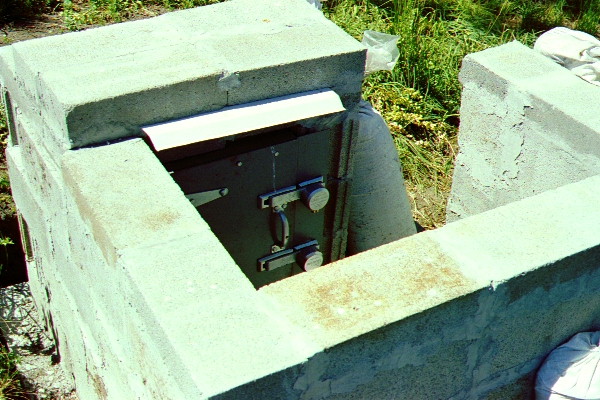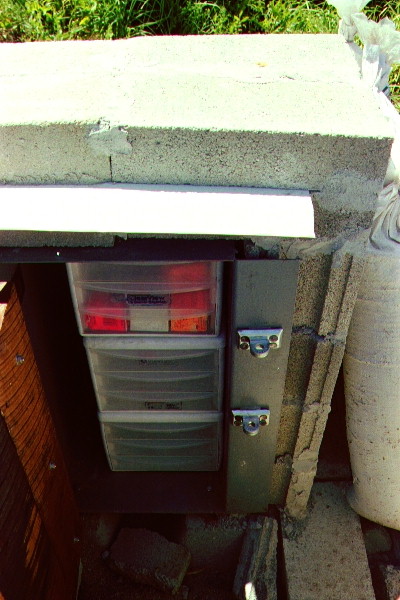Media Info
News releases
Fact sheets
Interview us
Myths & truth
Gun dictionary
Scary words
SEA Effects
FAQ
Home
Shirts, hats, stuff
Join News List
Privacy
Policy
My Interactions With The ATF
To date (March 2004) all my encounters with the ATF have been pleasant. They provided me with the regulations and recommendations for storage and manufacture of high explosives. I found the "Orange Book" they supplied quite useful. Particularly regarding building a storage magazine that is theft and bullet resistant. They twice visited my manufacturing/storage site and have been very reasonable to deal with. A third visit is scheduled for March 2004 for the new storage magazine the Taj Mahal.
The biggest hassle of complying with the ATF was building the actual storage magazine. Here are some pictures of the first one:

Exterior
Note the eight inches of concrete between the outside world and the steel box from any direction except from the air. The cinder blocks aren't hollow either. There is coarse sand tamped into all the hollow areas. Also note the high security locks. No ordinary bolt cutters will be effective on these locks.

The interior.
Two inches of hardwood on the inside of the door -- which is 1/4 inch thick steel. The steel box is bolted to several hundred pounds of concrete then the concrete blocks were built around the steel box adding to the theft resistance. The interior dimensions are 15.4" x 29.5" x 14.25". The plastic shelves shown above are no longer used. A nice lady (Crystal) from the ATF called in March of 2001 and expressed concern about static electricity and asked that I use cardboard or wood instead. I told her that my safety was of great importance to me also and I although I wouldn't use wood, but would be glad to switch to waxed cardboard. I don't want to use wood because spills of KClO3 could make the wood explosive and/or a very high fire danger. In December of 2001 another nice lady (Sue) from the Spokane office of the ATF came out to take pictures of the magazine. We had a nice drive out to the site and waded 200+ yards through the boot-top deep snow to the magazine. We talked about how I might put up another magazine for increased storage capacity at some time in the future. She had some good suggestions. She asked about the metal being covered with some sort of non-sparking material. I told her it was painted with enamel paint and the exposed bolts were zinc plated. She had me apply a sticker to the door warning that it was a Federal Crime to steal explosives and then she took pictures of the magazine. We talked about security and she asked if I had any attempted thefts or anything suspicious happen. Part of the increase in concern over things of this nature since the September 11, 2001 attack on our country. There wasn't anything of substance to report to her and she didn't seem surprised. It is a bit remote way out here, and the magazine holds so little material it really wouldn't be of much interest to someone wanting to blow up major buildings even if it were completely full.
The magazine will hold about 170 pounds in the packages I use for reactive targets. Far short of the 1800 pounds that the site is rated for by the ATF. In addition to the relatively small quantities stored here, probably 98% of the time the magazine is empty, making the probability of theft rather remote.
![]()
Email: Joe Huffman
Last updated:
March 12, 2004